The Great Salem Fire of 1914 was one of the last great urban fires of the era. It followed the Portland, Maine, fire of 1866, the Chicago Fire of 1871, the Boston Fire of 1872 and the Chelsea, Mass., fire of 1906.
The conflagration cut a swath a half-mile wide and a mile-and-a-half long through the city. Miraculously, the fire killed only three people, but injured 60. Even more people died from the strain of losing their homes.
The firestorm gobbled up 1,376 buildings, leaving homeless 18,000 people – nearly half of Salem’s population. The conflagration destroyed so many businesses that 10,000 people lost their jobs.
Early Warnings
Salem had long been susceptible to fire, but the city’s growth after the turn of the century made it more so. Since 1905, an influx of immigrants swelled the population by 28 percent to 48,000. More than 5,000 newcomers arrived in the four years since 1910. They were Irish, Italian, Polish and French-Canadian immigrants come to work in the mills, the wharves and the tanneries. With no choice but to move into unsafe buildings, hey jammed into neighborhoods like the French La Pointe.
Four years before the fire broke out, Selectman Franklin Wentworth warned it would happen. He wrote in a March 29, 1910 Salem Evening News article that the city was in danger of burning down. The city had too many combustible roofs, he argued.
No one, it seemed, paid any attention. Later, Wentworth became secretary of the National Board of Fire Underwriters.
The Great Salem Fire
Salem was in the midst of a drought on the hot, windy day of June 25, 1914. Early in the afternoon the fire started at the Korn Leather Co. in Blubber Hollow, the leather manufacturing district. Rays of sunlight through a window may have set a pile of celluloid on fire. It caught barrels of a highly inflammable material used to make patent leather — acetone, amalacitate and alcohol.
Contemporary newspaper reports quoted a state official describing what happened. He said the fire started in a shed filled with sheepskin and three barrels filled with highly flammable substances. He didn’t know how the flames originated, but once they did they spread to the barrels and the sheepskins, then up the open elevator well to the third floor. There the floor had been saturated with the flammable substance.
The first alarm went off at 1:37 p.m. The fire spread so quickly a general alarm sounded four minutes later, and terrified Korn workers had to run for their lives from the burning building.
The block to the east caught immediately. So did the factories to the west. The fire crossed the street and consumed a factory and half a block of brick buildings. It swept down Boston Street and quickly doomed the entire district. Fire alarm boxes were pulled right and left as the fire swept through Salem.
Destruction
Historic Lafayette Street, one of the most beautiful in the city, was ravaged. A change in wind direction spared Chestnut Street and the McIntire Historic District. Ninety percent of Salem’s historic structures escaped the inferno.
The city’s entire French neighborhood was destroyed, including the newly built St. Joseph’s Church. Salem’s Franco-American population dropped to 5,000 from 15,000 after the fire.
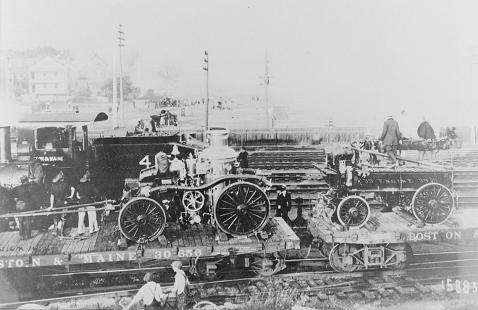
Fire apparatus sent by rail from Boston used to put out the Salem fire. Photo courtesy Boston Public Library.
Firefighters from 21 cities and towns came to help. The Boston Fire Department sent fire apparatus by rail car. Hingham firefighters soaked rugs and clothing in salt water, then laid them on roofs to prevent the fire from spreading. Ten homes were dynamited to stop the fire in its path.
Kittens and Ice
Many of the firefighters were overcome by the intense heat, and lay down in puddles for relief.
Some people panicked and ran into their burning homes, only to retrieve items of little value. One woman seized a small piece of ice, another a pillow and a gallon of oil. A washerwoman saved a new broom. A man saved a watermelon.
A woman gave her husband two hatboxes to take to a safe place. One had his two best suits, the other two kittens. He joined a throng at the docks and decided he could only carry one hatbox, so he threw the one with the kittens into the harbor. He later found he’d thrown out his suits and saved the kittens.
Families sought refuge in public spaces, bringing what household goods they could save to the Salem Common, the Salem Willows, Forest River Park, and the Broad Street Cemetery.
Finally the Salem fire was out, 13 hours after it began. It continued to smolder, though. Three weeks later, Pickering’s coal pile and Ropes’s hay were still burning. Gone were factories, churches, homes, barns, schools, bridges, wharves, coal piles and shops.
The ruined city became an instant tourist attraction. It is estimated 1 million people came to see the smoldering ruins the next day.
Recovery
Even before firefighters extinguished the Salem fire, National Guardsmen handed out cookies and milk.
Fearing civil unrest, Gov. David Walsh had called up 1,700 militiamen. They were ordered to shoot looters on sight, but the only disturbance involved a resident reentering a guarded area.
The National Guard set up emergency aid stations during the fire. The Salem Armory became relief headquarters and clearinghouse for fire victims.
Tent cities sprang up at Bertram Field at the high school, Forest River Park and Camp Sherry near the Willows. Food and clothing was distributed. The first business to reopen was a tent barbershop on Boston Street. Guardsmen handed out food, issuing about 6,000 rations a day in breadlines by the tent cities.
Aftermath
Within a year of the Salem fire, the city issued 353 permits for buildings in the burned-over district. Most were one and two-family dwellings. Salem adopted a new building code requiring fireproof construction, widened streets and planted hundreds of shade trees.
Asbestos manufacturer Johns-Manville took full advantage of the Salem fire, running an ad under a photo of the Naumkeag Steam Cotton Co. that proclaimed:
Unharmed in the Midst of the Great Salem Fire because Roofed with J-M Asbestos Roofing
“The Roll of Honor”
Flying sparks and burning embers were literally showered upon the roof of this raw cotton storehouse of the Naumkeag Steam Cotton Co., located in the midst of the recently flame-swept area of Salem, Mass.
Buildings all around it were burned to the ground, as the photograph shows.
Yet this building was absolutely unharmed because protected by J-M Asbestos Roofing.
Salem never rebuilt its manufacturing base to its previous size. The city changed into a college and tourist town and a bedroom community swallowed up by metropolitan Boston.
According to legend, the ghost of Giles Corey, Salem witch trial victim, haunted the graveyard on the night before the fire.
To see 150 images of the fire at the Peabody-Essex Museum’s Phillips Library Digital Collections, click here.
With thanks to Streets of Salem and The Salem Fire by Arthur B. Jones. This story about the Salem fire was updated in 2024.
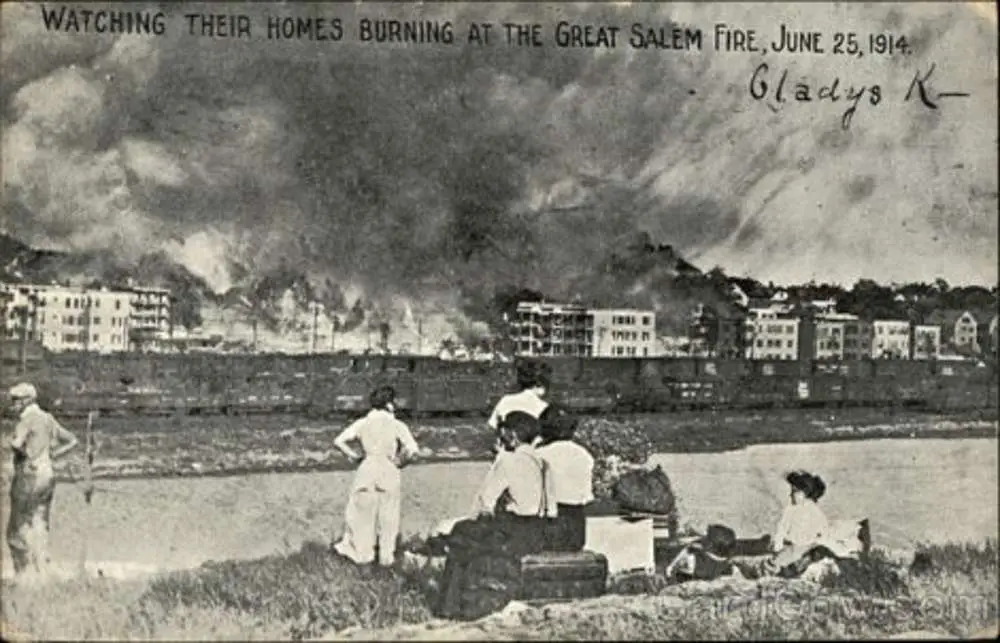

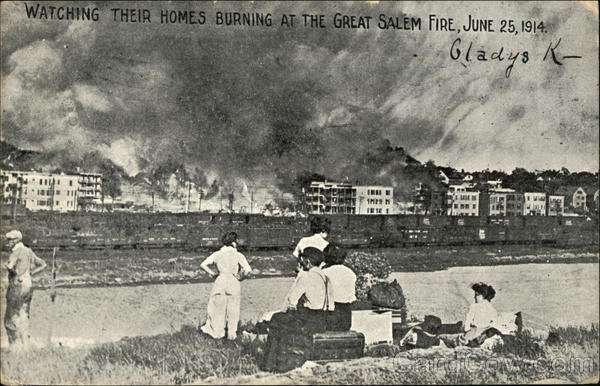
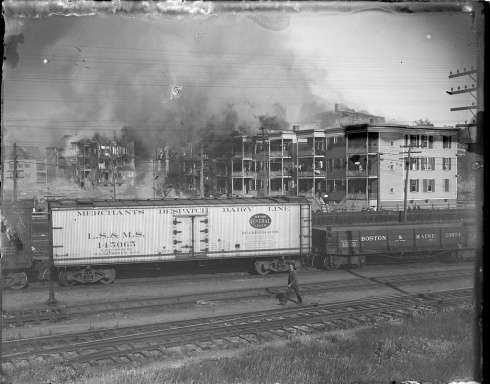
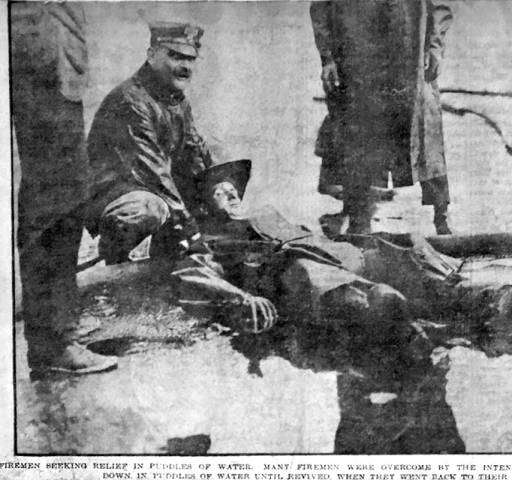

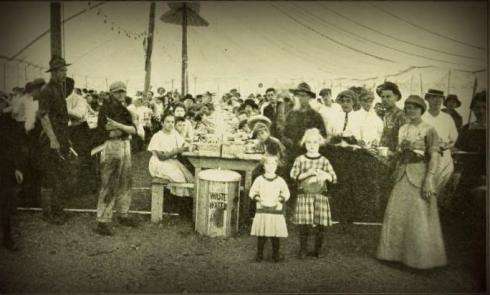

6 comments
[…] Hartford Circus Fire was one of the worst fire tragedies in U.S. history. It happened during the afternoon performance of the Ringling Brothers and Barnum […]
[…] a small-town girl from Southborough, Mass. Six months later, one of his houses burned down in the Salem fire of 1914. An insurance adjustor told him he could expect a hefty […]
[…] Hartford Circus Fire was one of the worst fire tragedies in U.S. history, killing about 170 circus-goers and injuring more than 700. It happened 18 months […]
[…] Lucy was the daughter of Joseph F. and Della Alice Rich Smith. Starting in the early 1900s, it was Joseph who began selling water from our spring and delivering it all over around the North Store in horse drawn wagons. We were fortunate to hear a story from John Smith, brother of Lucy, who told us about water being drawn from the spring to help fight the Great Salem Fire of 1914. […]
[…] Hartford Circus Fire was one of the worst fire tragedies in U.S. history, killing about 170 circus-goers and injuring more than 700. It happened 18 months […]
[…] has allegedly appeared in the cemetery before something terrible is about to happen, including a 1914 fire that burned down a sizable proportion of the city. There has also been a series of tragedies that have hit the Salem sheriff’s […]
Comments are closed.